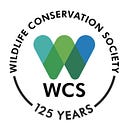How the American Bison Became Our National Mammal
By Madeleine Thompson, WCS Institutional Archivist
The story of the restoration of bison to the American West is one that is well known in both conservation and zoo circles. During the nineteenth century, the mass slaughter of bison with the settlement of the West brought the species to the brink of extinction. In 1889, future Bronx Zoo Director William Hornaday published a stark portrait of the species’ destruction.
Titled The Extermination of the American Bison, Hornaday’s study found that the American bison population, which at one time numbered between 30–50 million animals, had fallen as low as 1,000, and in fact, the number would continue to drop over the following 15 years.

and Game Preserve (now known as the Wichita Mountains Wildlife
Reserve), October 1907. William Hornaday appears on the left.
Credit: © Wildlife Conservation Society.
In 1905, Hornaday and several other major figures in the conservation and sportsmen communities convened at the Bronx Zoo and formed the American Bison Society (ABS). With then–President Theodore Roosevelt (who had pledged his support for the group) as the Society’s honorary president, the ABS set out to prevent the extinction of the American bison.
Remarkably, within just ten years, the ABS accomplished its goal by establishing several small herds — sometimes with animals from the Bronx Zoo — in widely separated preserves across the country. By 1934, an ABS census estimated that the population ofbison in the U.S. had grown to roughly 4,400 — more than four times the numbers from 30 years earlier.
This remains one of conservation’s greatest success stories and a shining example of how zoos can make significant contributions to further conservation goals and save species.

If this narrative has become familiar to many, perhaps what is less known is the diverse, behind-the-scenes effort by hundreds of people across the country that went in to achieving this success. This took the form of tremendous physical labor — in the raising and care of the animals, in the surveys of the potential lands to serve as preserves, and in the transport of bison across the U.S. to these preserves.
This effort also took the form of intense, regular census research to understand the population status of the American bison. In 1907, for instance, Hornaday surveyed dozens of zoo, park, and preserve administrators; ranchers; and animal dealers to analyze and document the size of the American bison population. Responses flooded in from across the world — from the Charles Goodnight ranch in Texas to the Askania-Nova reserve in Russia.

responses from the Davenport Zoological Park.
Credit: © Wildlife Conservation Society.
The ABS’s success was additionally due to the support not only of President Roosevelt but also of dozens of legislators. In 1908, several members of Congress, led by Montana Senator Joseph M. Dixon, secured the passage of the Bison Range Act, under which the U.S. government provided lands in Montana for a national bison herd.
For his part, in the months leading up to the passage of the act, Hornaday sent out letters to 150 newspaper editors around the country encouraging “articles and editorials which will lead people to take an active interest in the serious business of rendering the future of the bison species absolutely secure.” Apparently, the newspapers delivered: a scrapbook Hornaday kept that documented his work on the national bison herd is filled with clippings from papers across the country heralding the Bison Range Act’s merits.

to 150 newspaper editors encouraging articles on the
bison campaign, March 1908.
Credit: © Wildlife Conservation Society.
When suitable land for the establishment of the new herd was secured, the ABS turned to the American people for their assistance in raising the $10,000 required to purchase animals that would serve as the breeding nucleus for the herd. As a flyer promoting the subscription fund noted, “Any American can give a dollar; some can give more.” Although many Americans did give much more than a dollar, it was the hundreds of small donations of $5 or less that allowed the ABS to exceed their fundraising goal by more than $500.
Today, we celebrate President Obama signing the historic National Bison Legacy Act signed into law. We laud the work that has gone into its passage and we also remember the efforts of Americans from all walks of life before us, led by the American Bison Society, that have ensured that bison continue to thrive in this country today.

Bison Herd subscription flyer, 1908.
Credit: © Wildlife Conservation Society.
— — — — — — — — — — — — — — — — — — — —
Dr. Madeleine Thompson is Institutional Archivist at WCS (Wildlife Conservation Society).
